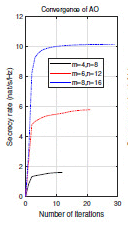clc
clear all
iterations=30;
%% Parameter
m=4; % number of BS
n=8; % number of RIS
K=1; % number of users in
L=1; % number of Eve
P=db2pow(30); %(watts) Maximum shared power source budget
eta_i= sqrt(10^(10/10)); % Maximum amplification coefficient at each reflecting element
epsilon=sqrt(0.002); % Bound level of estimation error
sigma_B=(db2pow(-90)); %(watts) Noise power
sigma_E=(db2pow(-90)); %(watts) Noise power
sigma_I=(db2pow(-90)); %(watts) Noise power
alpha_AI=2.1; % Pathloss exponent
d0 = 1; % pathloss reference distance
beta = 0.5; % Power splitting ratio
w = rand(m,1) + 1j * rand(m,1);
%%% Channels%%%
H_AI = rand(n, m) + 1j * rand(n, m);
disp(H_AI); % Display the channel matrix
h_IB = rand(1, n) + 1j * rand(1, n);
disp(h_IB); % Display the channel matrix
h_IE = rand(1, n) + 1j * rand(1, n);
disp(h_IE); % Display the channel matrix
%%% Rician Factor %%%
Rican_AI=5;
Rican_IB=5; Rican_IE=5;
%%%%% Large scale path loss
PL_0=10^(-30/10); %dB the channel gain at the reference distance
x_bs=0;
y_bs=0;
x_RIS=50;
y_RIS=50;
%% Channel Matrices and vectors
H_DA= sqrt((x_RIS-x_bs)^2+(y_RIS-y_bs)^2); %m distance from the BS to RIS
pathloss_AI = sqrt(PL_0*(H_DA)^(2.1)); % Large-scale pass loss from the BS to the RIS
x_user=100; y_user=0;
h_DB = sqrt((x_RIS-x_user)^2+(y_RIS-y_user)^2); %m distance from the RIS to the bob user
pathloss_IB = sqrt(PL_0*(h_DB)^(2.1)); % Large-scale pass loss from the RIS to the bob user
x_eve=50; y_eve=0;
h_DE = sqrt((x_RIS-x_eve)^2+(y_RIS-y_eve)^2); %m distance from the RIS to the Eve
pathloss_IE = sqrt(PL_0*(h_DE)^(2.1)); % Large-scale pass loss from the RIS to the Eve
%%%%% Rician Channel Fading %%%%%%%%%%%%%
%ricianCh(chSize, ricianFactor, dist, pathLossRef, distRef, pathLossExp, freq, phi)
H_AI = sqrt(1/2).*ricianCh([n m], 5, H_DA, PL_0, d0, alpha_AI, 2.4e9, pi/10); % Rician Channel for H_AI
h_IB = sqrt(1/2).*ricianCh([1 n], 5, h_DB, PL_0, d0, alpha_AI, 2.4e9, pi/10); % Rician Channel for h_IB
h_IE = sqrt(1/2).*ricianCh([1 n], 5, h_DE, PL_0, d0, alpha_AI, 2.4e9, pi/10); % Rician Channel for h_IE
%%Now generating the phase shift atrix in RIS
% Create phase shift matrix
phi = rand(n, n) + 1j * rand(n, n);
h_IE_bar = h_IE;
%% Optimize variable
%% AO algorithms
%% SCA algoritms
for ite=1:iterations
disp([' ite = ', num2str(ite)])
cvx_begin
variable S;
variable mu;
variable t;
% S = 1;
% mu = 1;
t_bar = t;
t_til = t;
t_bar = exp(t_til)*(t-t_bar+1);
I = sigma_B + norm(h_IB*phi)^2 *sigma_I;
h_B = h_IB*phi*H_AI;
H_A = phi*H_AI;
C = t*sigma_I*phi*phi';
A = t*sigma_I*phi*phi'-phi*H_AI*w*w'*H_AI'*phi';
maximize(log(1+trace(h_B*S*h_B') / I)-t);
constraintA = trace(S) <= beta*P;
constraintB = trace(H_A*S*H_A') <= (1-beta)*P;
subject to
constraints1 = [constraintA, constraintB];
X = [C + mu*I - H_A*S*H_A' (C-H_A*S*H_A')*h_IE_bar';
h_IE_bar*(C-H_A*S*H_A') h_IE_bar*A*h_IE_bar'-mu*epsilon+t*sigma_E];
real(X) >= 0;
S >= 0;
mu >= 0;
cvx_end
disp([' itePhy = ', num2str(ite)])
cvx_begin
variable V(n,n);
variable mu;
tau = 1;
H_B = diag(h_IB)*H_AI*w*w'*H_AI'*diag(h_IB)';
H_IB = diag(h_IB)*diag(h_IB)';
H_I = diag(H_AI*w)*diag(H_AI*w)';
H_eff = (exp(t)-1)*sigma_I*I-(H_AI*w*w'*H_AI')';
trace(H_B*V)-tau*(sigma_B + trace(H_IB*V)*sigma_I);
constraint1 = trace((H_I + sigma_I * I) * V) <= (1 - beta) * P;
constraint2 = diag(V) <= eta_i;
subject to
constraints = [constraint1, constraint2];
Y = [conj(V.*H_eff)+mu*I, conj(V.*H_eff)*h_IE_bar';
h_IE_bar*conj(V.*H_eff)' h_IE_bar*conj(V.*H_eff)*h_IE_bar'+sigma_E*t_bar-mu*epsilon];
real(Y) >= 0;
mu >= 0;
tau > 0;
cvx_end
end
%% Define the Secrecy Rate of Bob and Eve
B = log(1 + abs(h_IB * phi * H_AI * w)^2./ (sigma_B + norm(h_IB * phi)^2 * sigma_I)); % Secrecy Rate of Bob
E = log(1 + abs(h_IE * phi * H_AI * w)^2./ (sigma_E + norm(h_IE * phi)^2 * sigma_I)); % Secrecy Rate of Eve
%% Maximize Secrecy Rate
secrecy_rate = B - E;
%% Figure
plot(iterations,secrecy_rate,‘k-o’, ‘LineWidth’, 2);
xlabel(‘Number of iterations’);
ylabel(‘Secrecy rate(nat/s/Hz)’);
title(‘Convergence of AO’);
I need this graph so please help me .
